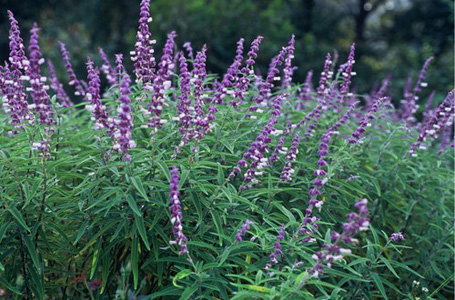BRING ON THE BUTTERFLIES: LUPINE VS. MEXICAN SAGE
By Cassy Aoyagi: What’s 4×4 with beautiful spikey flowers all over? Both Lupine and Mexican sage will answer the riddle, but only Lupine does it with ridiculously little water. While the flowers may look similar enough to you and me, Mission Blue Butterflies seeking a honeymoon location head strait for California native Lupine.
Mexican Sage and Lupine flowers are similar enough to confuse most garden lovers, but in actuality, the plants are quite different. While Mexican Safe is subtropical, equally elegant Lupine comes from dryer chaparral and coastal sage regions of California and Oregon. Lupine:
Is the [butterfly] hostess with the mostest. Lupine hosts native Califonria butterflies that reproduce only when living on a few species of Lupine. It also protects those it hosts. For example, the Mission Blue Butterfly lays its eggs, which become Lupine-eating caterpillars. As a result, the caterpillar and future butterfly alike become unappealing to predators, as their Lupine diet gives them a bitter taste.
Provides year-round delight. Although Lupine has a short but striking bloom season, it does not need to be cut back like Mexican Sage. It’s silvery, unique foliage will add sparkle to the garden throughout the year.
May be elegant or simply cheery. There are multiple species of native Lupine, both annual and perennial. While its imperial purple is most comparable to Mexican sage, there is a perky yellow flowering species as well.
Follows fires. You can always rely on Lupine to follow fire, bringing desecated hillsides back to life.
April is a great time to see beautiful varieties of Lupine as well as the Mission Blue Butterflies it attracts.

Mexican Sage
Mexican Sage is perrenical in California and produces a desireable essential oil. Pair those qualities with its Lupine-like towers of blooms, and it seems like a winner.
Disappears in the off-season. While perennial, Mexican sage requires severe, ground-level cut backs to produce new growth the following season. While it regenerates, the garden will have a bare spot.
Needs water to bloom. One place where Mexican Sage won’t want a cut-back is in the water. Because it is native to tropical and subtropical regions where humidity is higher and water is more available, it will need supplemental water to bloom.
Sparks no romance. While Mexican Sage is lovely, it is not a suitable habitat for Mission Blue Butterflies to reproduce…that is the crowning glory of its competition, Lupine.
For more guidance on where to plant big dry ones, see our past Wet-to-Dry Exchange articles.
